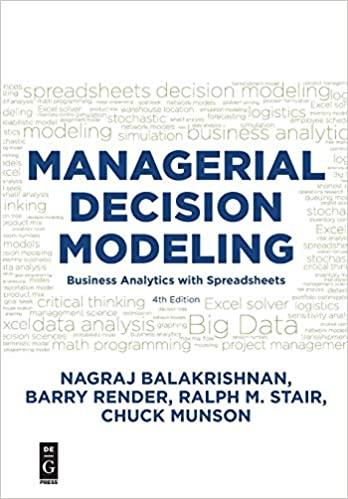The newsvendor model is a classic inventory problem based on the situation of newsstand owner who must
Question:
The newsvendor model is a classic inventory problem based on the situation of newsstand owner who must determine how many newspapers to order early in the morning to satisfy that day’s demand. She has one chance to purchase. At the end of the day, unsold newspapers are thrown away. On the other hand, if demand exceeds the order size, then the newsvendor loses potential sales.
So the question is, with uncertain demand and a single chance to purchase, how many units should be purchased? The answer is typically not to order expected demand. Instead, the optimal order size should represent a trade-off between the cost of ordering too much and the opportunity cost of not ordering enough.
We let Q = order size (the decision), U = cost per unit of unmet demand (underage), and O = cost per unit of excess inventory (overage). It turns out that for any distribution function of demand, F(), the best order decision is to select Q such that F() = U / (O+U).
For some distributions, we can solve this general equation for the best order size Q* directly. In particular, (1) for the uniform distribution between a and b, Q* = a + (b−a)[U/(O+U)], and (2) for the normal distribution with mean μ and standard deviation σ, Q* = μ + zσ, where z comes from the Standard Normal Distribution table for the “critical ratio” value of U/(O+U). Using Excel, z = NORMSINV(U/(O+U)).
Create simulations to test these policies. Using Excel, analyze the uniform distribution in sheets 1 through 5, and analyze the normal distribution in sheets 6 through 10. The cost to buy the units is $60 each (this represents the overage cost). The items can be sold for $100 each. (Thus, the underage cost is the margin on a sale of $100 − $60 = $40.) Enter the revenue and cost per unit at the top of sheet 1 (and use cell references on the other sheets to retrieve those). For the uniform distribution, assume that demand is uniformly distributed between 1000 and 5000 units (integers only). For the normal distribution, assume that demand is normally distributed with a mean of 5,000 and a standard deviation of 1,000. On each sheet, enter the appropriate distribution parameters at the top of the sheet, somewhere near the costs. Use 10,000 trials for each analysis.
Indicate the trial number in column A. In column B, compute the random demand. Place the order size in column C, and calculate the revenue in column D. Revenue equals the sales price per unit times the minimum of the demand (column B) and the order size (column C). Place the actual cost in column E, which equals the cost per unit times the order size (column C). In column F compute the profit for that trial (column D minus column E). Note that it is possible for the profit to be negative for any given trial.
For both of your distributions, test the following strategies (put each in a separate sheet):
(a) Order the optimal strategy given by the formulas above;
(b) Order average demand (this equals (a + b) / 2 for the uniform distribution, and it equals μ for the normal distribution);
(c) Order randomly each time (use the same formula in column C as you have in column B);
(d) Order the previous trial’s demand (use a random order size for the first trial);
(e) Order 4,000 for the uniform, or order 6,000 for the normal.
Record your average profit, minimum profit, and maximum profit (over the 10,000 trials) for each of your strategies, and put the results in a small table. Did the optimal solutions from part (a) perform best?
Step by Step Answer:

Managerial Decision Modeling Business Analytics With Spreadsheet
ISBN: 9781501515101
4th Edition
Authors: Nagraj Balakrishnan, Barry Render, Ralph Stair, Charles Munson





